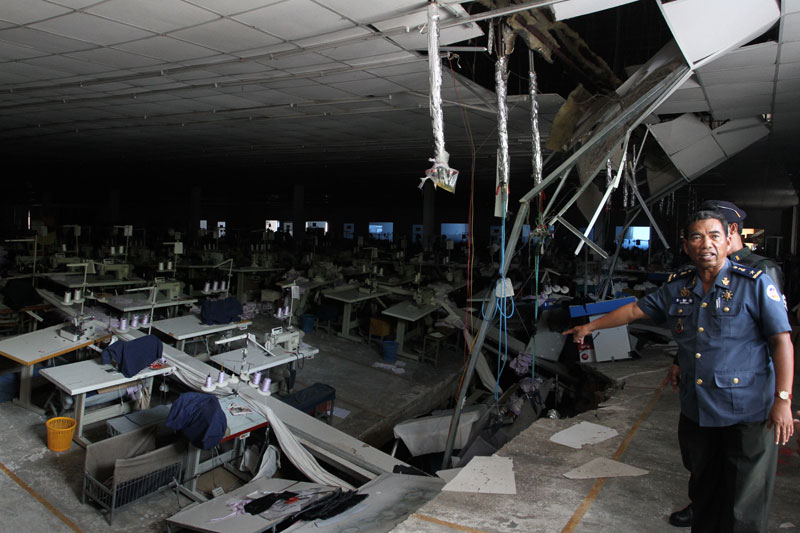BATI DISTRICT, Takeo province – At least eight workers sustained minor injuries Tuesday morning after the floor of a clothing factory in Takeo province collapsed, once again raising concerns about a lack of oversight of building standards in the crucial garment sector.
At the Chinese-owned Nishiku Enterprise factory—which labor monitors say produces clothes for Swedish clothing giant H&M—sewing machines and debris from the ceiling, which was pulled down by the collapsed floor, littered the bottom of a 50-meter-long and 3-meter-deep slab that dropped into a water basin below the factory floor.

The collapse occurred “because the foundation was not good enough,” said Pok Vantha, deputy director of the Ministry of Labor’s health department, who visited the factory in the afternoon. He said the ministry would launch an investigation into the incident and determine whether the company followed a proper engineering plan prior to construction.
Nishiku Enterprise employs about 1,650 people, 800 of whom work inside the building where the collapse occurred, according to factory management.
Chhun Sareth, chief of Takeo’s internal security bureau, said he also received reports that the floor buckled due to a weak foundation built on land that had become saturated with water due to heavy rainfall.
“The reason the building collapsed into the ground is because a lot of rain fell this morning and the…foundation is not strong,” Mr. Sareth said.
Outside the Bati district referral hospital Tuesday, 24-year-old Long Chanrong was among eight injured workers laying on mats and cots, some hooked up to intravenous drips.
“As I was working, I heard a crack and I fell into the basin,” she said. “I fell about two meters and lost consciousness.”
Don Phary, 24, who is pregnant, was admitted to the hospital for stomach pains she experienced after colliding with the hundreds of panicking workers who rushed for the exit after the floor caved in.
“I was working away from where it collapsed, but I’m pregnant, so the problem with my stomach occurred when I bumped into other people while rushing out,” said Ms. Phary, adding that workers were concerned about the state of the building before the incident.
“Before the building collapsed I would wonder, ‘Why is the floor moving?’” she said. “I always used to think that, and then it collapsed.”
Tuesday’s incident comes 17 months after a ceiling collapsed at the Wing Star Shoes factory in Kompong Speu province, killing two workers and seriously injuring seven.
Mr. Vantha of the Labor Ministry drew parallels between Tuesday’s incident, last year’s deadly factory collapse and the Savar building disaster in Bangladesh last year, which killed more than 1,100 garment workers.
“There were similar problems with Wing Star…. When they constructed it, they did not build it to the proper standards and the foundation was of poor quality,” he said. “If we look at Bangladesh, they did this too and the whole building collapsed.”
Jill Tucker, chief technical adviser for the International Labor Organization’s Better Factories Cambodia program, which monitors health and safety standards in the country’s garment factories, said there was a “long chain of responsibility” for Tuesday’s incident.
“Firstly…you have to have building standards so you can hold people accountable. Secondly, there needs to be enforcement of these standards and that’s the governmental role, and I think all of us that are involved in assessing working conditions need to look more closely at building safety,” Ms. Tucker said.
Chan Molika, human resources manager for Nishiku Enterprise, declined to say when the latest safety inspection had taken place, but said the building where the collapse occurred was constructed three years ago.
She said that after the collapse, the factory immediately sent managers to count workers and ensure that no one was missing, stressing that the injuries sustained were only minor.
“There were 1,600 workers—800 in the building—and none of them were seriously injured.”
(Additional reporting by Khy Sovuthy)